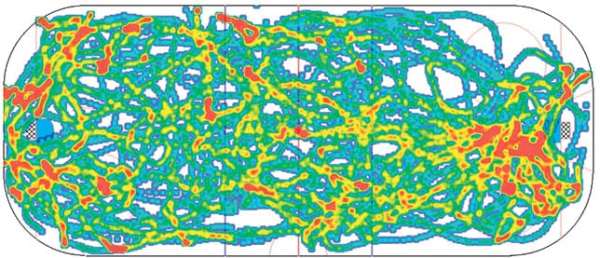
Although the advanced stats revolution has been swift, it’s by no means complete. Corsi and Fenwick have easily displaced plus-minus as a go-to metric in evaluating a player’s worth to a team, but video could soon supplant a few fancy stats thanks to new camera technology that tracks puck possession.
 NHL teams advancing past advanced stats with state-of-the-art video
NHL teams advancing past advanced stats with state-of-the-art videoAlthough the advanced stats revolution has been swift, it’s by no means complete. Corsi and Fenwick have easily displaced plus-minus as a go-to metric in evaluating a player’s worth to a team, but in essence, those measures are simply more accurate versions of plus-minus, since they draw from a bigger sample size of shots instead of goals. What the so-called fancy stats crowd really wants to know is whether or not a player is driving puck possession when he’s on the ice or simply tagging along while a linemate does all the work. And as amusing as it may be to picture a blogger painstakingly pausing their DVR every time a pass is made in a game to write down who has the puck and for how long, a much more rational solution is coming to the fore. Video is the savior, but not just any video. We’re talking about cameras that record an image every one-tenth of a second, compiling reams of data that can then be sorted by programs to give a more accurate representation of what’s going on during a game. “You can throw Corsi out the window,” said Marc Appleby of PowerScout Hockey. “Because we know how long a player had the puck.” So for every Chris Kunitz or Pascal Dupuis hater who thinks Sidney Crosby does all the work on his line, the answer will arrive soon. PowerScout, which has teamed up with tracking tech company ProZone Sports, was originally hatched from analytics research in 2009. It had contracts with two NHL teams last season but recorded more than 50 games in 25 NHL and major junior rinks overall. Using three Ultra-HD cameras, Appleby’s firm can set up in any rink, right down to midget games, and doesn’t require any permanent installation (though that’s also an option). The cameras track every action in the game and the raw data is filtered through a cloud-based portal called Icetrax. The range of applications is stunning: a client team can look at zone entry speeds, how long a player holds the puck, the distance between two defense partners and even heat maps (see example, for Crosby, below) that show where a player spends most of his time on the ice. “We’re actually measuring the little things,” Appleby said. “We’re analyzing on a micro-level.”
Appleby is a second-generation stats fiend. His father, Terry Appleby, invented a board game called National Pro Hockey back in 1985, which took real NHL player stats and allowed players to assemble lineups, with results based on probability. That same concept has led to one of PowerScout’s most ambitious goals: figuring out if a player made the best choice when he had the puck. Using probability, the company can mine countless situations from the past and see what the ultimate outcomes were. For example, if Taylor Hall carries the puck into the offensive zone, is he better to stop inside the blueline and wait for help or charge to the net? PowerScout can look at the probability of the Oilers scoring on that play and relay that info to the team, which can then tell Hall if his instincts are helping or hindering. Video analytics first came into sports in the 1990s, when optical tracking was used in soccer. The practice has expanded to many sports, including basketball, where PowerScout’s main competition reigns. SportVU, a technology run by the company STATS, uses six cameras for NBA games and is installed in all 30 team arenas via the catwalk. SportVU is interested in hockey, and the battle for hearts and minds is being waged in meetings throughout North America. Still, even among the game’s most progressive minds, there’s doubt. “The camera structure and logistics of it would have to be changed for hockey because of the different dimensions of the surface, how difficult it is to track the puck and the issues hockey has versus soccer and basketball,” said Kyle Dubas, the Toronto Maple Leafs’ new assistant GM and a darling of the advanced stats community. “In hockey, substitutions can happen on the fly, while in the other sports it has to be at a stoppage. So it’s being able to identify which players are going on and off the ice. I think there are some companies doing that stuff now, but we’re still a long way away from where we need to go.” If you’re worried all this info will take the fun out of hockey, keep in mind that even Appleby doesn’t project a cookie-cutter NHL should video win the day. “Teams define scoring chances differently,” he said. “We want to give them data that compares apples to apples.” If the NHL teams do become believers, however, there will no doubt be a rush to order. Every edge helps when building a Cup contender.
This feature originally appeared in the September 15, 2014 edition of The Hockey News magazine. Get in-depth features like this one, and much more, by subscribing now.


